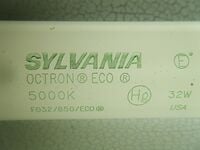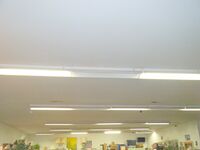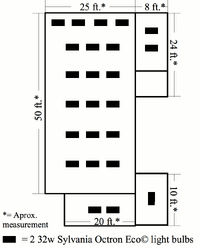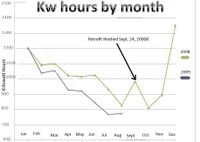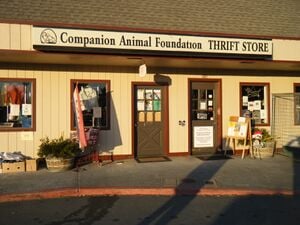
Redwood Coast Energy Authority offered many local businesses an opportunity to achieve higher energy efficiency. By tracking a company's energy use through an audit, the Redwood Coast Energy Authority was able to propose achievable savings in carbon dioxide emissions, energy usage, and dollars. The Redwood Coast Energy Authority recommended to each business a particular set of retrofits that would help them to reach these savings. The Companion Animal Foundation (Figure 1) is one of many businesses that accepted the offer. The proposed retrofit consisted of replacing the buildings fluorescent lighting. This page will describe the different aspects that contributed to the Companion Animal Foundation's decision to work with the Redwood Coast Energy Authority. Also, Information on the retrofits numerous effects to the store are discussed.
About Companion Animal Foundation[edit | edit source]
Mission Statement
"Companion Animal Foundation's goal is to raise the status of animals by decreasing the pet overpopulation through spay/neuter assistance, education and adoptions. We strive to provide meaningful programs for both youths and adults which increase awareness of the unique relationship we share with our animal friends. Lastly, we seek to work cooperatively with all animal rescue groups as well as the community to find good homes for adoptable animals." The Companion Animal Foundation(CAF)
The Companion Animal Foundation is a non-profit organization. In order to implement care for animals, appropriate funding is needed. Therefore, the Companion Animal Foundation takes advantage of any opportunity to save money or raise funding. The Redwood Coast Energy Authority brought about an opportunity to the foundation's attention that might not only save the company money through energy efficiency, but raise sales as well.
Thrift store
When first entering The Companion Animal Foundation, one may not immediately be aware of just how involved with animals this company really is. Over 75% of the space available for this establishment is used as a thrift store (Figure 2). The thrift store sells just about anything; from DVDs and books, to clothing and jewelry. The revenue from sales of these items is paramount in the operation of the Companion Animal Foundation. In fact, 100% of the Companion Animal Foundation's sales support the adoption center. The new lighting installed helps brighten up merchandise. Marty Massey (the store manager of CAF) feels that the lighting could potentially raise sales for the thrift store.
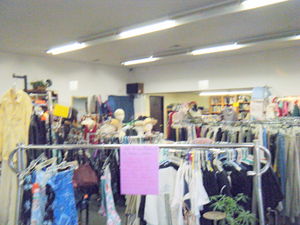
Adoption center
As the Companion Animal Foundation's mission statement implies, animals (particularly cats) are the main focus of this business. Abandoned kittens and stray cats are often brought to the Companion Animal Foundation. Shelter for these felines helps eliminate the overpopulation of cats locally. The foundation also helps the community by taking potentially adoptable kittens/cats from the county shelter. Unfortunately, as fast as felines are adopted, new strays and abandoned kittens are brought in. Taking care of animals (no matter how endless of a cycle it may seem) is the Companion Animal Foundation's main purpose. There are many costs involved in the process of such care. The Companion Animal Foundation views any monthly savings due to energy efficiency as money that can be used to care for the increasing feline population they support. A short list of some of the costs accrued by the care of each cat is shown below (Table 1). Costs shown are approximations given by the Companion Animal Foundation's store manager.
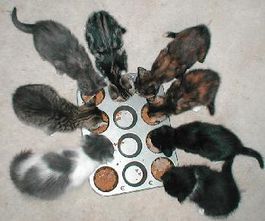
| Table 1. Approximate costs of care | |
|---|---|
| Tested for FeLV and FIV | $14 per cat |
| De-flead, checked for earmites, and de-wormed | $4 per cat |
| Vaccinated | $4-$12 per cat |
| Spayed or neutered prior to adoption | $35-$50 per cat |
| Fed high quality cat food (Figure 3) | $15 a cat per month |
Retrofits[edit | edit source]
The installments
A total of 24 light fixtures line the ceilings of the Companion Animal Foundation. Each fixture holds two fluorescent bulbs. All 24 of these fixtures throughout the building were replaced (Figure 4) during the retrofit. Also, two new 32 watt Sylvania Octron Eco florescent bulbs (Figure 5) were installed into each fixture. A total of 48 bulbs were replaced. A layout of the current lighting set up is displayed in a diagram (Figure 6) of the Companion Animal Foundation's interior.
-
Figure 5. New 32 watt energy efficient bulb (photo by David Wittmers)
-
Figure 4. New fixtures were installed throughout the facility (photo by Sabre Ethridge)
Data
| Table 2. Costs and energy usage (before/after) | ||
|---|---|---|
| Type Data | Before retrofits (6 month average December 2007 to May 2008) | After retrofits (6 month average December 2008 to May 2009) |
| Cost per month | $167.63 / month | $158.25/ month |
| KWH usage | 1086.67 KWH / month | 998.5 KWH / month |
| Table 3. Savings and reductions (RCEA estimates/actual) | ||
|---|---|---|
| Type data | RCEA estimates | Actual changes |
| Dollars saved | $43.84 / month | $9.38 / month |
| Energy consumption reductions | 282.08 KWH / month | 88.17 KWH / month |
| Carbon dioxide emission reductions | 146.66 lbs. / month | 45.84 lbs. / month |
-
Figure 6. Layout of buildings current lighting system (designed by Sabre Ethridge)
-
Figure 7. Observable differences in energy usage after retrofit (design by David Wittmers)
Conclusion [edit | edit source]
The Companion Animal Foundation decided to undergo retrofits for a few different reasons. The company wanted to upgrade the quality of lighting throughout the building. Also, as a community serving organization, lowering the carbon dioxide emissions of the building was an additional benifit. In fact, when asked why the Companion Animal Foundation had the retrofits done, Marty Massey (store manager) replied, "To make the store brighter and more green".
The Companion Animal Foundation strives to conserve energy whenever possible. Besides a normal heating system, a few desk lamps, and other minor appliances, keeping the building lit during hours of operation is the only use of energy. The hours of operation for the Companion Animal Foundation have not changed over the last few years. Therefore, their energy consumption habits have remained relatively constant. This consistency can be viewed by a graph (Figure 7) of the first seven months of energy use in two separate years (2008/2009). One may observe that although the changes from month to month stay relatively uniform, a decrease in energy use is apparent between the two lines. This relationship is a reflection of the savings displayed in Table 2.
Although the estimates that the Redwood Coast Energy Authority had made for reductions in spending, energy use, and carbon dioxide emissions are not currently being met each month (Table 3), Marty said that the Companion Animal Foundation was "Extremely satisfied with their experience with RCEA". She feels that each of the company's reasons for getting involved with the retrofit was addressed. She went on to mention that "We would be happy to do more with the RCEA in the future if more retrofitting was ever needed. Dollars, air, and cats were saved".
References[edit | edit source]
- Redwood Coast Energy Authority
- The Companion Animal Foundation
- Auditor Mike Kowalski's Energy Efficiency Project summary
- Marty Massey (store manager)
